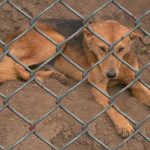Just like humans, dogs can be prone to plenty of different types of allergies, either within the environment or in their diet, or even items they come into contact with. It can be hard to detect an allergy in a pet let alone treat them because there may be one or more dog allergens within your premises.
In this guide, we’re exploring how you can first work out what kind of allergy your dog has, and next, treat it to ensure it doesn’t cause any further issues. Your pup doesn’t have to be in pain or discomfort just because they have an allergy.
Table of Contents
What are the Symptoms of Allergies in Dogs?
How do you even know what to look for? There are certain symptoms of allergies in dogs that you might not have even known about. Every dog is different, and some breeds are predisposed to certain conditions whereas others may not have the same likelihood of developing issues. All of this can make managing seasonal dog allergies even more difficult.
Symptoms of allergies in dogs vary, but can include:
- A lot of scratching on certain areas of the body
- Licking and grooming themselves excessively
- Ear infections
- Obvious skin abrasions and red, itchy areas
- Chewing the feet constantly
- Sneezing a lot in certain surroundings
- Scratching or rubbing at their face
- Vomiting and diarrhea
- Hair loss in patches
This isn’t a completely exhaustive list, and there are far more ways in which dogs might show symptoms of allergies. It’s absolutely vital that you know what might be triggering it or you could end up missing an allergy and being able to help your pet through.
What are the Common Dog Allergens?
It is important to know what the common allergens are. Each dog has their own unique genetic makeup and they might be more likely to have allergies triggered by these allergens, there are plenty of possible culprits.
- Grass, trees, and other plants and bushes can be an allergen for dogs which can make life very awkward for them, especially living in the countryside.
- Mold spores. Like humans, dogs won’t react well to mold getting into the air around them.
- Dust mites.
- Fleas are bad for all dogs but some pets can be allergic, causing double the issues.
- Cleaning products may contain chemicals that can irritate dogs and their systems.
- Smoke from cigarettes.
- Certain foods with certain proteins such as eggs, chicken and other meat, or even dairy and wheat allergies.
- Like humans, dogs might be allergic to certain types of medicines.
How to Reduce Allergens in Your Home and Garden?
So, what are some steps you can take to reduce the allergens and potential issues around your home? How can you make life easier for your pets? Let’s look at some methods of reducing allergens.
Avoid Plants and Houseplants that are Known to Cause Allergies in Dogs
Did you know that lots of houseplants can give your dog big problems? For instance, things like clover, tulips, and daisies can all give your dog irritation. Plants that we also get irritation from (things like stinging nettles) are also a problem for your canine friend.
Take an inventory of your houseplants and see if there is anything that could potentially be causing your dog’s allergies to flare up. It’s possible that just taking a few plants out of your garden or your home could make their life much more comfortable.
Install Artificial Grass in the Garden
You may not even think of your dogs may have allergies to grass. Surely a dog loves to run around and frolic in the grass. Well, it is possible that they could be allergic. Think about how often they are exposed to grass and you will start to understand what a severe issue this could be.
There might be times when you can’t avoid grass altogether, but in your own yard, it is very possible that you can help your dog out. If you use artificial turf your dog will be able to run around your own garden as much as you like without any worries.
Clean Surfaces with Hypoallergenic Spray
If allergens do get into your home then it is possible that you can get rid of some of them, and reduce the chances of them lingering and giving your dog problems for the future.
Hypoallergenic sprays can help to neutralize or get rid of the allergens that may be lingering on surfaces or in the air in your home, and they’re a wonderful way to give an extra bit of protection.
Regularly Change Air Filters, Use an Air Purifier or a Dehumidifier
It is easy to get very lazy when it comes to changing your air purifiers filters or HVAC filters. Make sure you get them regularly serviced so that the filters can actually do their jobs. Otherwise, instead of removing potential allergens from the air, you could just be circulating them around far more than you would ever want to.
Watch Out For Proteins and Toxic Food That Cause Food Allergies
This can be one of the more difficult types of allergen to figure out. It is possible that certain food items could be irritating your dog and causing issues including skin problems, diarrhea, sickness, and much more.
If you have an idea that your dog’s food could be causing problems, try to keep a food diary to see what your dog is eating and if there is any pattern. You might want to switch to something like easy-to-digest rice for a few days to see if this helps your pup, and this could give you an indication of whether the food is actually the cause of the problems. You can change the dog’s diet, but make sure you do this with care and gradually rather than making sudden switches if they aren’t required. This can also make a dog feel unwell.
Bottom Line:
Having a dog doesn’t mean that you have to feed it with some regular dog food or anything available in the kitchen but you need to be careful in choosing its diet. Also, you should make sure there are no dog allergens or any items in your home that may be uncomfortable for your dogs. Remember, these allergies can be turned into severe conditions if not taken care of.
Recommended read – Can dogs eat cat food?










